CHAPTER 5 SOCIO-ECONOMIC FACTORS IN INTERNET AND BROADBAND ACCESS - BY DWELLING AND HOUSEHOLD
In this chapter, socio-economic characteristics of households with Internet access is examined. Variables relating to households examined are:
Income
- Weekly equivalised household income
Dwelling characteristics
Household Characteristics
- Family composition
- Family blending
- Household composition
5.1. Income
In this study, weekly equivalised household income is used as a measure of income for examining the association of income on dwelling Internet access rates. Equivalised household income is the total household income adjusted by the application of an equivalence scale to facilitate comparison of income levels between households of differing size and composition. Equivalised household income can be viewed as an indicator of the economic resources available to a standard household. For a lone person household, it is equal to household income. For a household consisting of more than one person, it is an indicator of the household income that would be needed by a lone person household to enjoy the same level of economic wellbeing (see Census Dictionary for further detail).
Proportions of dwellings with Internet and Broadband access are higher for higher income groupings.
The $2,000 or more income group recorded the highest rate of Broadband connection (67%), and the rate of Broadband connection is lowest for the $150- $249 income grouping. Generally, connectivity increases with income.
Table 5: Internet Access by Weekly Equivalised Household Income(a) - August 2006 |
|  |
 | Any Internet | Broadband connection | Total |  |
 | Dwelling Records | Dwelling proportions | Dwelling Records | Dwelling proportions | Dwelling Records |  |
 | no. | % of Dwellings | no. | % of Dwellings | no. |  |
|  |
| Nil or negative income(b) | 43 456 | 57 | 30 553 | 40 | 76 863 |  |
| $1-$149 | 65 080 | 45 | 40 136 | 28 | 144 566 |  |
| $150-$249 | 177 092 | 35 | 97 293 | 19 | 509 077 |  |
| $250-$399 | 476 199 | 41 | 260 106 | 22 | 1 157 919 |  |
| $400-$599 | 695 317 | 60 | 407 042 | 35 | 1 150 684 |  |
| $600-$799 | 684 942 | 70 | 424 101 | 43 | 980 944 |  |
| $800-$999 | 504 333 | 76 | 327 540 | 49 | 666 924 |  |
| $1000-$1299 | 554 724 | 80 | 377 487 | 55 | 690 055 |  |
| $1300-$1599 | 320 272 | 84 | 227 470 | 60 | 381 170 |  |
| $1600-$1999 | 199 738 | 87 | 148 501 | 64 | 230 449 |  |
| $2000 or more | 179 182 | 86 | 139 063 | 67 | 207 296 |  |
|  |
| (a) Cells in this table have been randomly adjusted to avoid the release of confidential data. |
| (b) This income group consist of people with income from unincorporated enterprises or rental properties. The income may be reported negative when a loss accrues to a household as an owner or partner in unincorporated enterprise or rental property. Losses occur when operating expenses and depreciation are greater than gross receipts (ABS, 2007c). Thus this group can include people with considerable wealth. |
Figure 16: Internet Access by Weekly Equivalised Household Income, (Broad Income Groups)
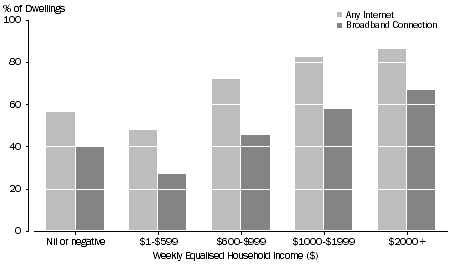
5.2. Type of tenure
People with home with a mortgage have a significantly higher level of connectivity in comparison with Renters, Outright owners and Other tenure types.
Internet access by type of tenure show a large variation among the different types. The Being purchased mortgage category has the highest proportion of any Internet (80%) and Broadband (54%) connection.
The Being occupied under a life tenure scheme category show the lowest proportions of any Internet and Broadband connection. Dwellings occupied under a life tenure scheme includes arrangements in retirement homes.
The Fully owned and Being occupied rent-free categories show similar proportions.
Figure 17:Internet Access by Tenure Type of the Dwellings - August 2006
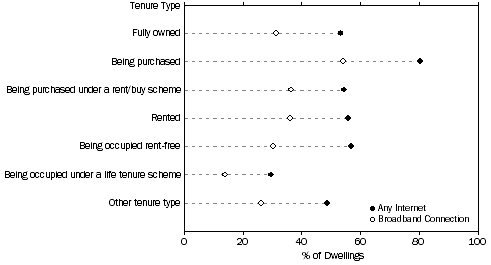
5.3. Family and household characteristics
5.3.1 Family composition
Family composition classifies families into different types. In doing so, information about temporarily absent family member is also used. No provision has been made to classify family members outside the family nucleus. For example, in a family which contains a couple and their dependent children, plus a parent of one of the couple, the latter is recorded as an Other related individual. For details of the categories of family composition please see the Census Dictionary. Table 6 gives the summary of Internet access by the family composition in private occupied dwellings.
Table 6: Internet Access by the Composition of Families , in Private Occupied Dwellings - August 2006 |
|  |
 | Any Internet |  | Broadband connection |  |
 | Family
Records | Proportions
of families |  | Family
Records | Proportions
of families |  |
 | no. | % |  | no. | % |  |
|  |
| Couple family without children | 1 186 865 | 63 |  | 724 407 | 38 |  |
| Couple family with children under 15 and dependent students | 255 918 | 92 |  | 189 536 | 68 |  |
| Couple family with children under 15 and no dependent students | 1 093 654 | 83 |  | 730 340 | 55 |  |
| Couple family with no children under 15 and with dependent students | 282 551 | 94 |  | 215 357 | 72 |  |
| Couple family with no children under 15, no dependent students and with non-dependent children | 316 262 | 75 |  | 210 926 | 50 |  |
| One parent family with children under 15 and dependent students | 51 203 | 77 |  | 34 722 | 52 |  |
| One parent family with children under 15 and no dependent students | 217 531 | 58 |  | 129 619 | 35 |  |
| One parent family with no children under 15 and with dependent students | 84 143 | 83 |  | 57 046 | 56 |  |
| One parent family with no children under 15, no dependent students and with non-dependent children | 136 921 | 54 |  | 81 409 | 32 |  |
| Other family | 50 315 | 59 |  | 34 176 | 40 |  |
|  |
Couple families with children under 15, with or without dependent students, recorded significantly higher connectivity than similar lone parent families, or couple families without children or students. Figure 18 presents Internet access broad level composition of families in private occupied dwellings. Dependent children includes both children under 15 and dependent students.
Figure 18: Internet Access by Family Composition - August 2006
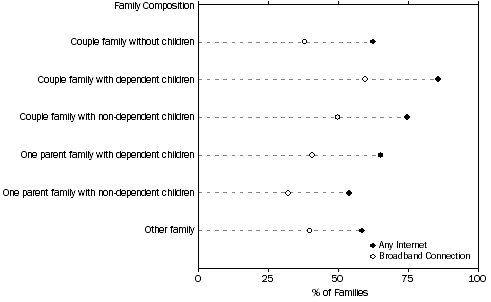
5.3.2 Family blending
Categories considered in this analysis relate to couple families only, based on the parent-child relationships within them.
The results indicate that blending of families have an impact on access to the Internet. Intact couple families with no other children present, recorded the highest proportion of any Internet (85%) and Broadband (58%) access (Figure 19). The lowest proportion of any Internet (62%) and Broadband (39%) access is recorded by the dwellings with Couple family with other children present. This category refers to couple families containing one or more children, all of whom are neither the natural children of either partner in the couple, nor step children of both partners in the couple. The presence of other children (such as foster children, or grandchildren) is associated with lower proportions of Internet access.
Figure 19: Internet Access by Couple Family Blendings, August 2006
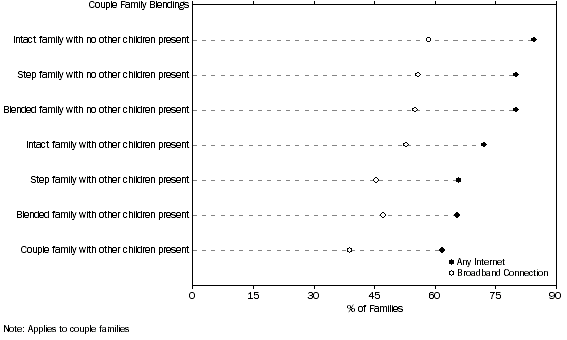
5.3.3 Household composition
A dwelling could consist of more than one family. Figure 20 illustrates the variation of proportions of Internet connectivity with respect to household composition. Two family households recorded the highest rate of any Internet (73%) and Broadband (50%) access. One family households recorded similar proportions to the two family household (72% any Internet and 47% Broadband). Lone person households have the lowest proportion of any Internet (37%) and Broadband (20%) access.
Figure 20: Internet Access by Household Composition - August 2006
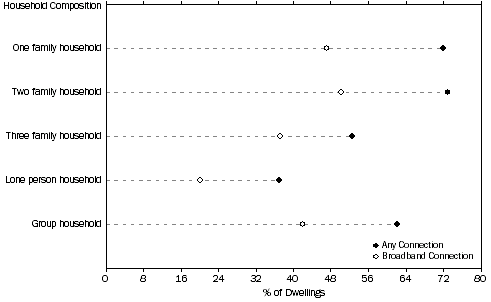
 Print Page
Print Page
 Print All
Print All